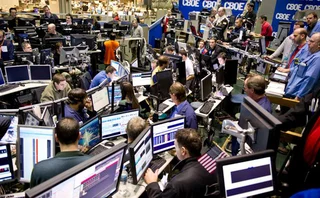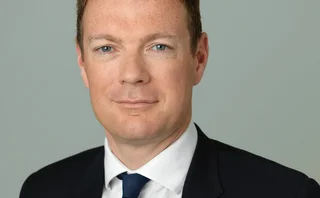
FX Invest: New indexes trade volatility
Facing the fear

Once-in-a-lifetime financial shocks used to be just that. But the past three years have offered ample opportunities to work out how to protect yourself in extreme trading environments. And the answer, it seems, is to take a punt on the fear and uncertainty itself: trade volatility.
This is not news to the buyers of some million contracts a month on the Vix, the Chicago Board Options Exchange’s volatility index of global equities – dubbed the ‘fear gauge’. The index, based on implied volatility of S&P500 options, is the most looked at indicator of expected global volatility. It recorded its busiest ever month in March, amid the Japanese earthquake and nuclear crisis, and the worsening situation in Libya and the Middle East. To May this year it reported 20 consecutive months of year-on-year growth as investors increasingly turn to it to hedge equity risk.
Now a number of banks are launching similar indexes based on currency market volatility. They argue foreign exchange volatility can act as a good indicator of risk in other assets in times of extreme stress – and because the FX market is so liquid and so broad, it can be cheaper to trade volatility in FX than in other asset classes.
“We were seeing a lot of demand from clients – FX and non-FX – who are interested in using FX for tail-risk hedging,” says Simon Hards, global head of FX options trading and structuring at Credit Suisse in London. Tail risk is the risk of unlikely but damaging events, such as the Lehman Brothers collapse in September 2008. “Investors want to create a hedge in such a way that they have substantial returns in stressed environments but don’t make significant losses when volatility subsides.”
So Credit Suisse set about creating a product that would fit that bill, and in February unveiled the Credit Suisse Advanced Volatility Index – CSAVI. The portfolio includes 12 of the most-liquid G-10 currency pairs and uses jump diffusion – an options pricing model that prices moves by jumps, as well as continuous ‘diffusion’; this allows for the larger price moves seen in extreme events.
There is operational difficulty with trading volatility: mistakes can be costly. Customers that buy an index are outsourcing this issue, and pushing all this risk onto someone else
FX is particularly suited to tail-risk hedging, says Anthony Ring, index specialist in FX structuring at Credit Suisse in London, because it is a liquid market, and because there is less systematic positioning than in equities as people trade FX for a variety of different reasons rather than just investment. “The market isn’t as crowded with one particular view,” says Ring.
Previously these customers might have dabbled in the FX market for the same purpose – putting on big rouble trades, for example as a hedge against large movements in the price of oil. Another popular strategy recently, says Hards, is to buy long-dated dollar/China high strikes. “The market expectation is that the currency would move the other way: in a major global crisis, hedgers would expect to see a good return on this strategy.”
The index format, however, makes strategies like these more accessible. “Many investors will be restricted in their ability to enter these types of specific over-the-counter contracts. This could be due to external regulation, internal trading policy or simply a lack of time and expertise in that particular area,” says Ring. As such, CSAVI has gone down well with pension and insurance fund clients, who might be limited by rules and regulations, and with hedge funds who might want to buy in time savings and expertise.
The index has been designed to deliver strong positive returns during extreme events, but crucially, not to dip into negative performance in the good times. “This has been created as a buy-and-hold strategy, since, by their very nature, it is not easy to predict when an extreme event will happen,” says Hards.
Between July 2007 and January 2011, for example, the strategy generated a Sharpe ratio of 0.87, compared with –0.34 for the Vix Futures Index (the figure is 0.02 for the S&P 500). In the stressed environment of July to December 2008 it generated a Sharpe ratio of 4.54 compared with 2.97 for the Vix (and –0.95 for the S&P500).
BNP Paribas has also been hard at work developing products in this area.
It is about to launch an entire family of indexes trading FX volatility to exploit the volatility risk premium – that is the difference between realised (or actual, historical) volatility and implied (or future, expected) volatility.
“Historically, implied volatility tends to overestimate realised volatility for short-dated options. This is because investors are willing to pay a premium for options to guard against the possibility of a major shock,” says Vincent Berard, European head of interest rates and FX structuring at BNP Paribas in London.
The family – collectively called Nebula – is divided into three-sub-groups of six. Each index buys straddles on the same 12 currency pairs and delta hedges daily; they all operate in the same way, but at slightly different times or in slightly different ways.
Nebula 1 comprises six ‘consistently short’ indexes; the Nebula Enhanced group all have various risk management features embedded in them; and Nebula Plus are all long biased volatility indexes. Clients can combine them to get the exposure they want, or customise indexes to reduce the number of currency pairs.
Nebula is targeted at sophisticated institutional clients who see volatility as an asset class, and who are looking for a way to diversify exposure, says Angelo Mastromarini, senior systematic strategy and index structurer at BNP Paribas in London. These clients could of course execute an equivalent trading strategy themselves, but buying exposure in an index is cheaper and cuts out all execution risks, he explains.
“The cost of trading the underlying varies a lot: EUR/USD is liquid, and the spreads are tight, but when you move to less-liquid currencies, the cost is more meaningful. Buying Nebula, customers can substantially reduce the cost of trading the underlying as the indexes are managed in conjunction with the option trading book of the bank,” he says. “Secondly, there is operational difficulty with trading volatility: mistakes can be costly. Customers that buy an index are outsourcing this issue, and pushing all this risk onto someone else.”
The Nebula range follows on from another currency volatility index the bank launched two years ago, called Vola. This is a weighted average of the three-month realised volatilities of the six most traded currency pairs. By buying forward contracts on the index, you can express a view on volatility in the same way as you might on the Vix.
Backdated, this strategy would have returned 65% during the Lehman crisis – from mid-August 2008 to the end of that year, compared with the S&P losing 30%. During the Long-Term Capital Management crisis in November 1998, it would have returned 64%, compared with a 13% loss for the S&P. “This strategy is super-efficient for systemic crises,” says Berard.
The downside is that it does not work in extreme events that do not spread to FX – for example the dotcom bust in 2001/02, when it would have lost 45%. “Then the volatility that was present in equity markets did not spread to FX because it was a specific crisis. There is no ‘one size fits all’ in risk protection,” he says.
JP Morgan’s offering is quite different. It has three separate indexes, which it describes as ‘indicators’ of implied currency volatility rather than tradable benchmarks. The VXY for G-7 currencies and VXY-EM for emerging markets were first launched in 2006, but have recently been updated to add new currencies and rebalance the currency weights according to more recent market share statistics. VXY Global was launched in March and aggregates 22 currencies from the VXY and VXY-EM indexes.
Underlying volatilities are based on three-month at-the-money forward options and the indexes are weighted by market share of options pairs as determined by the latest Bank for International Settlements triennial survey (the most recent data is from December 2010).
The three indexes provide clients with indicators for use in their own trading models, rather than an off-the-shelf investible product to generate returns, says John Normand, head of global FX strategy at JP Morgan in London.
“A lot of investors are looking for volatility signals to trade in the cash market, and VXY provides an easily accessed input for their models,” says Normand. “It also allows them to compare volatility in currencies with that of other asset classes, such as the Vix, for investors who think that, on occasion, movements in volatility in one market might lead movements in other markets.”
Normand says the indexes are useful for any client – corporate or investor – who finds value in tracking the derivatives markets for evidence of complacency or excessive pessimism. “Extremes in volatility are often associated with turning points in cash markets,” explains Normand. “Above-average volatility usually suggests pessimism is excessive, so the dollar could soon fall and high-yield currencies rally. Below-average volatility suggests complacency is widespread, so the dollar could then rally and high-yield currencies fall.”
As yet, it is impossible to tell whether these new products do what they say on the tin. That won’t be clear until they pay off – or don’t – in the event of the next big market blowout.
In the meantime, one investment firm sounds a note of caution.
“The financial crisis reminded us that things that behave in a certain way in certain market environments might change completely in other environments. This is particularly an issue when you’re looking at tail risk,” says Jeppe Ladekarl, director of research at First Quadrant in Pasadena, California.
“If you go into this thinking it will make you money, you will be disappointed. This is a type of insurance. You should go into it thinking: ‘How much of my return should I pay to insulate against tail risk?’
“But even if you do get the event that you bought the insurance for, you might not recoup the premium that you paid for it. It’s like partial insurance: you might not get the full replacement costs, but you’re going to get something. Depending on your personal circumstances, that might be worth a lot.”
Only users who have a paid subscription or are part of a corporate subscription are able to print or copy content.
To access these options, along with all other subscription benefits, please contact customer services - www.fx-markets.com/static/contact-us, or view our subscription options here: https://subscriptions.fx-markets.com/subscribe
You are currently unable to print this content. Please contact customer services - www.fx-markets.com/static/contact-us to find out more.
You are currently unable to copy this content. Please contact info@fx-markets.com to find out more.
Copyright Infopro Digital Limited. All rights reserved.
You may share this content using our article tools. Printing this content is for the sole use of the Authorised User (named subscriber), as outlined in our terms and conditions - https://www.infopro-insight.com/terms-conditions/insight-subscriptions/
If you would like to purchase additional rights please email info@fx-markets.com
Copyright Infopro Digital Limited. All rights reserved.
You may share this content using our article tools. Copying this content is for the sole use of the Authorised User (named subscriber), as outlined in our terms and conditions - https://www.infopro-insight.com/terms-conditions/insight-subscriptions/
If you would like to purchase additional rights please email info@fx-markets.com
More on Exchanges
Moscow Exchange expands Asia and Middle East presence with Avelacom
Co-operation with tech firm lets exchange improve PoP in London, reducing latency by five milliseconds
Crypto to look more like FX market in 2019, says B2C2
Over-the-counter tipped to gain in importance, but faces funding and credit constraints, says cryptocurrency market-maker
SGX snaps up 20% stake in BidFX
Exchange invests $25m in TradingScreen spinoff, expects to boost liquidity by adding OTC to FX futures
CBOE pulls plug on bitcoin futures trading
First mainstream exchange to offer bitcoin futures calls halt as it reviews approach to crypto
Independent Reserve joins OTCXN network
Australian crypto exchange joins to attract more institutional liquidity
CME to retire Nex, revives EBS as sub-brand
The deal between the two firms will go ahead after full regulatory approval in all jurisdictions
CME shifts FX options expirations in step with OTC
Latest move by exchange to make FX offering more harmonised and engaged with over-the-counter space
SGX’s Lam in bid to bring together two worlds
SGX set to launch FlexC FX Futures in August, with the aim of combining the best that OTC and futures have to offer







